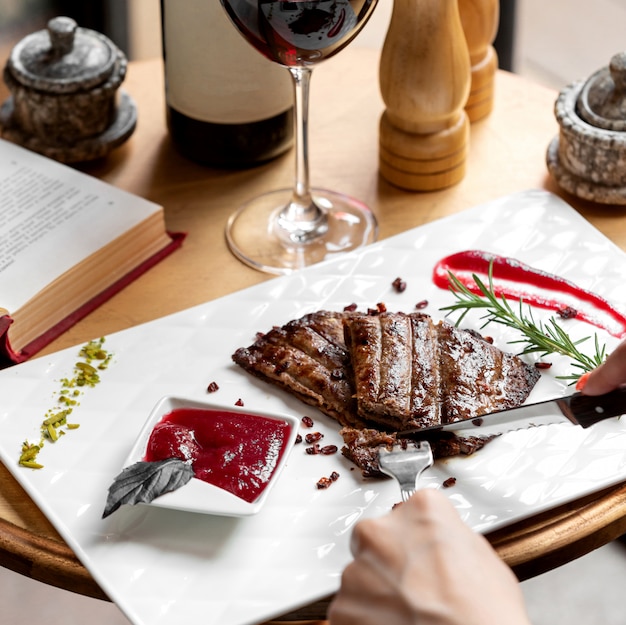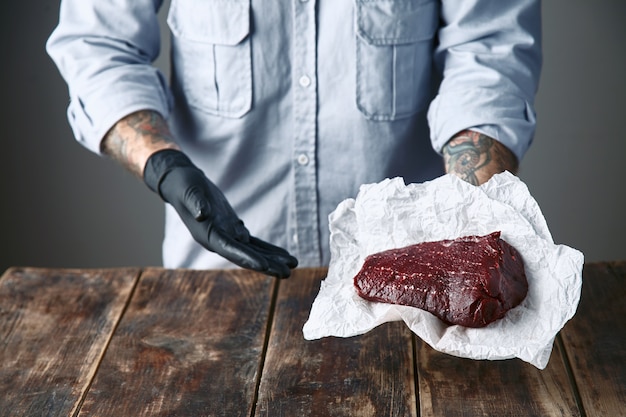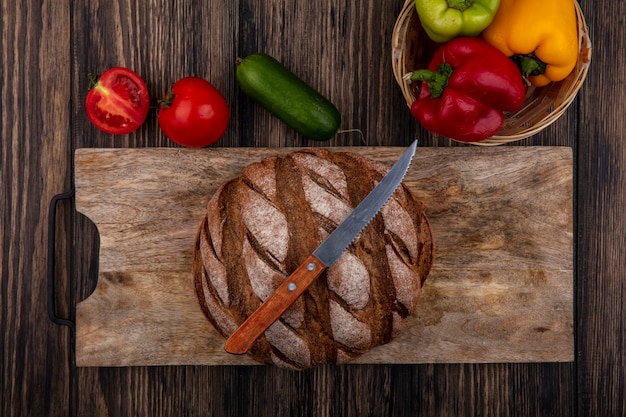Ah, steak. The mere mention of it conjures up images of sizzling, juicy perfection, a symphony of flavors that dance on your taste buds. For years, I've been on a quest to master the art of cooking steak, experimenting with different cuts, techniques, and temperatures. And let me tell you, there's nothing quite as satisfying as biting into a perfectly cooked steak – that satisfying "melt-in-your-mouth" tenderness with a delightful pink center. But achieving this culinary nirvana requires a bit of know-how, especially when it comes to nailing that coveted medium-rare. This is where a trusty steak cooking time chart comes in handy, guiding you towards steak perfection.
(Part 1) Deciphering the Steak Code: Temperature and Thickness

Think of cooking steak as a little code you need to crack. Two key elements are temperature and thickness – knowing these will ensure your steak doesn't end up overcooked or underdone. A meat thermometer is your best friend here. For medium-rare, you're aiming for an internal temperature of 130-135°F (54-57°C). Go lower, and you're venturing into the realm of rare, which some find a tad too raw. Go higher, and you're pushing towards medium, medium-well, and eventually, well-done, which can be quite dry and tough.
Thickness: A Steak's Hidden Secret
A steak's thickness plays a crucial role in its cooking time. Thin steaks cook much faster than their thicker counterparts. A 1-inch thick steak needs just 2-3 minutes per side to reach that glorious medium-rare, while a 2-inch thick steak might take 4-5 minutes per side. It's all about understanding the steak's anatomy and adjusting your timing accordingly. Some folks prefer the "thumb test," where you gently press the center of the steak to gauge its firmness. It can be a useful tool, but honestly, a thermometer is more reliable, giving you a precise reading.
(Part 2) Cooking Methods: A Trio of Steak Champions

There are three main methods for cooking steak: pan-searing, grilling, and broiling. Each method has its own charm and impact on the final result.
Pan-Searing: A Crispy Embrace
Pan-searing is ideal for smaller steaks, allowing you to create a beautiful, crispy crust while locking in the juicy goodness within. You'll need a heavy-bottomed pan and medium-high heat. Make sure the pan is nice and hot before you introduce the steak – a scorching surface sears it beautifully. You'll need a good quality oil, like olive oil or grapeseed oil, to prevent sticking. Sear each side of the steak for 2-3 minutes, or until you see that gorgeous golden-brown crust.
Grilling: A Smoky Symphony
Grilling is a classic way to cook steak, especially for larger cuts. You'll want a quality grill, charcoal or gas, and remember to crank up the heat – you want that grill roaring! The goal is to char each side of the steak for 3-5 minutes, creating those tantalizing grill marks. Keep an eye on the internal temperature, ensuring it hits your desired doneness range. A trusty grill thermometer is a great companion in this process.
Broiling: Quick and Fiery
Broiling is your go-to method when you need a quick and easy way to cook a steak. Preheat your broiler to high heat, place the steak on a baking sheet, and broil for 2-3 minutes per side, or until it's nicely browned and reaches your desired internal temperature.
(Part 3) The Steak Cooking Time Chart: Your Culinary Compass

Now, let's delve into the heart of this article – the steak cooking time chart. This handy tool is your culinary compass, guiding you towards steak perfection.
Thickness: The Key to Timing
We'll break down the chart by thickness, as these are the most common sizes you'll find in your local butcher shop or supermarket. We'll also factor in a range of doneness levels, from rare to well-done.
| Thickness (inches) | Rare (125-130°F) | Medium Rare (130-135°F) | Medium (135-140°F) | Medium Well (140-145°F) | Well-Done (145°F and above) |
|---|---|---|---|---|---|
| 1 | 2-3 minutes per side | 2-3 minutes per side | 3-4 minutes per side | 4-5 minutes per side | 5-6 minutes per side |
| 1.5 | 3-4 minutes per side | 3-4 minutes per side | 4-5 minutes per side | 5-6 minutes per side | 6-7 minutes per side |
| 2 | 4-5 minutes per side | 4-5 minutes per side | 5-6 minutes per side | 6-7 minutes per side | 7-8 minutes per side |
| 2.5 | 5-6 minutes per side | 5-6 minutes per side | 6-7 minutes per side | 7-8 minutes per side | 8-9 minutes per side |
Remember, these are just guidelines. You might need to make adjustments based on your grill's heat, your steak's thickness, and the temperature of your kitchen.
Resting Time: A Steak's Moment of Tranquility
Once your steak is cooked to perfection, resist the urge to devour it immediately. Let it rest for 5-10 minutes before slicing and serving. This allows the juices to redistribute throughout the meat, resulting in a more tender and juicy steak. It's like giving the steak a moment of tranquility after its intense cooking experience.
(Part 4) The Art of Seasoning: Enhancing Steak's Natural Symphony
Now, let's talk about seasoning. Salt and pepper are the foundation, but don't be afraid to explore a world of flavors. Here's my go-to seasoning recipe, a blend that elevates the steak's natural symphony:
- Salt: I'm a fan of kosher salt, and I don't hold back. I season the steak generously on both sides before cooking, allowing the salt to penetrate and enhance the steak's natural flavor.
- Pepper: Freshly ground black pepper is my weapon of choice. A good grind adds a nice, peppery bite, complementing the savory richness of the steak.
- Garlic Powder: A touch of garlic powder adds a subtle yet distinct savory flavor, adding another dimension to the overall taste profile.
- Onion Powder: This brings a depth of savory complexity, working in harmony with the other spices.
- Paprika: A sprinkle of paprika adds a touch of warmth and a vibrant color to the steak, complementing the overall presentation.
I like to rub the seasoning into the steak, ensuring every nook and cranny is coated, guaranteeing an even distribution of flavor.
(Part 5) Additional Tips: Mastering the Art of Steak Cooking
Here are some additional tips to ensure your steak reaches its full potential:
- Room Temperature: Before cooking, take the steak out of the fridge and let it sit at room temperature for 30 minutes to an hour. This allows the steak to cook evenly, preventing a cold center.
- Don't Overcrowd: Don't overcrowd the pan or grill. This will lower the temperature, preventing the steak from achieving a beautiful, crispy sear.
- High Heat: Use high heat to sear the steak. This creates that desirable, delicious crust, adding a layer of flavor and texture.
- Flip Once: Only flip the steak once during cooking. This minimizes the loss of precious juices, ensuring a tender, juicy steak.
(Part 6) Marinades: Adding a Layer of Flavor
Marinades can add a dimension of flavor to your steak, but they're not a necessity. If you choose to use a marinade, let the steak soak for at least 2 hours, or even better, overnight. If you're using a marinade that contains acidic ingredients like lemon juice or vinegar, pat the steak dry before cooking to prevent it from becoming overly mushy.
(Part 7) My Personal Steak Preferences: A Culinary Confession
Now, I know everyone has their own steak preferences. I personally adore a good medium-rare steak, cooked to about 132°F. I like my steak to have a char on the outside and a juicy, pink center, a symphony of textures and flavors that I find irresistible. I'm also a big fan of using a dry rub, allowing the steak's natural flavors to shine. And, of course, I always let my steak rest for at least 10 minutes before slicing and serving, allowing the juices to redistribute and create that perfect bite.
(Part 8) steak pairings: Harmonies of Flavor
No steak is complete without the right accompaniments, side dishes that complement and enhance the steak's flavors. Here are a few of my favorite steak pairings:
- mashed potatoes: Creamy and comforting, mashed potatoes are a classic steak side. Their smooth texture and richness create a perfect balance with the steak's savory notes.
- Roasted Vegetables: Roasted vegetables, like asparagus, broccoli, or Brussels sprouts, offer a vibrant contrast in flavor and texture. Their smoky sweetness and char complement the steak beautifully.
- grilled corn on the Cob: Grilled corn on the cob adds a smoky sweetness and a touch of rustic charm to the dish, complementing the steak's savory notes.
- Green Salad: A fresh green salad with a light vinaigrette helps to balance out the richness of the steak, offering a refreshing contrast and a burst of freshness.
- Red Wine: A good red wine, like Cabernet Sauvignon or Merlot, is a perfect complement to a juicy steak. The wine's tannins and fruitiness complement the steak's richness, creating a harmonious flavor experience.
(Part 9) FAQs: A Steak Lover's Guide to Answers
1. What is the difference between rare, medium-rare, medium, medium-well, and well-done steak?
The different levels of doneness refer to the internal temperature of the steak and the level of pinkness. Here's a breakdown:
- Rare: 125-130°F (52-54°C) – The center of the steak will be very red and almost raw. This is a highly personal preference, appreciated by those who enjoy a pronounced "beefy" flavor.
- Medium Rare: 130-135°F (54-57°C) – The center of the steak will be pink and juicy, with a tender texture. This is the classic doneness level for many steak enthusiasts, offering a balance of flavor and tenderness.
- Medium: 135-140°F (57-60°C) – The center of the steak will be slightly pink, with a more cooked texture. This is a good option for those who prefer a less pronounced "beefy" flavor.
- Medium Well: 140-145°F (60-63°C) – The center of the steak will be mostly brown with a touch of pink, with a firm texture.
- Well-Done: 145°F (63°C) and above – The center of the steak will be completely brown, with a dry and firm texture. This is for those who prefer their steak cooked through.
2. How do I know when my steak is done?
The best way to tell when your steak is done is to use a meat thermometer. Insert the thermometer into the thickest part of the steak, making sure to avoid hitting any bone. Once the internal temperature reaches your desired doneness level, the steak is ready.
3. Can I cook a steak from frozen?
It's generally not recommended to cook a steak from frozen. This will result in uneven cooking and a tough, chewy steak. The steak won't cook evenly and might result in a dry, tough texture. It's best to thaw the steak in the fridge overnight or in a bowl of cold water for a few hours before cooking.
4. What are some good cuts of steak for grilling?
Some of the best cuts of steak for grilling include ribeye, new york strip, filet mignon, and sirloin. These cuts are all naturally tender and flavorful and will cook beautifully on the grill.
5. What are some tips for keeping steak juicy?
Here are a few tips for keeping your steak juicy:
- Don't overcook it: Overcooked steak will be dry and tough. Use a meat thermometer to ensure you cook it to your desired doneness level.
- Let it rest: Allow the steak to rest for 5-10 minutes after cooking. This will allow the juices to redistribute and make the steak more tender.
- Don't pierce it: Avoid piercing the steak with a fork while cooking. This will cause juices to escape, resulting in a drier steak.
- Use a thermometer: A meat thermometer will help you cook the steak to the perfect internal temperature, ensuring it's cooked to your liking.
Everyone is watching

Corn on the Cob: The Ultimate Guide to Perfectly Cooked Ears
Healthy MealsAh, corn on the cob. Just the name evokes images of sunny days, barbecues, and that sweet, juicy flavour that ...

Perfect Pork Roast Oven Cooking Time: A Guide to Delicious Results
Healthy MealsThere's something truly satisfying about a perfectly roasted pork. The aroma alone is enough to make your mout...

Ham Cooking Time: How Long to Bake, Smoke, or Boil a Delicious Ham
Healthy MealsAh, ham. It's a classic, isn't it? A real crowd-pleaser, especially around holidays. And when done right, it'...

Scallops: The Ultimate Guide to Perfect Cooking
Healthy MealsAh, scallops. Those delicate, sweet, and utterly delicious morsels of the sea. They hold a special place in my...

Spaghetti Squash: The Ultimate Guide to Cooking and Serving
Healthy MealsRemember that time you saw spaghetti squash at the supermarket, looking all bumpy and strange, and thought, "W...
